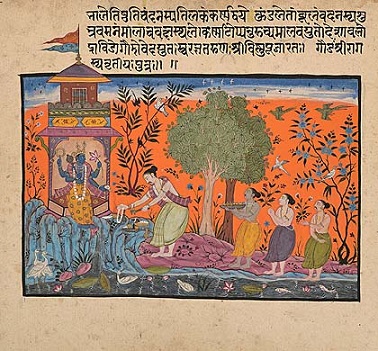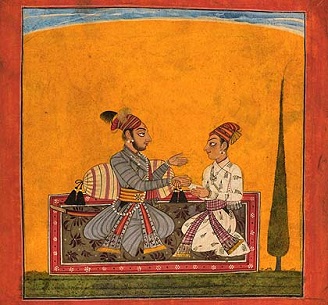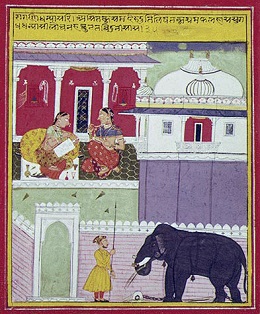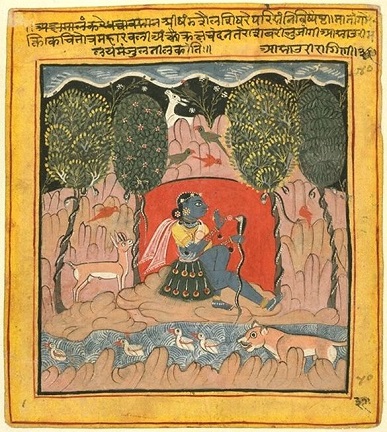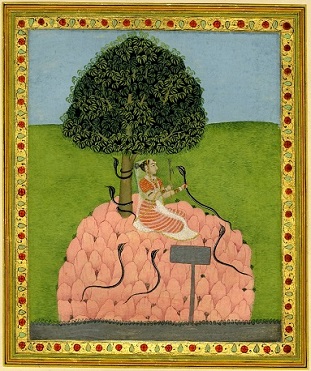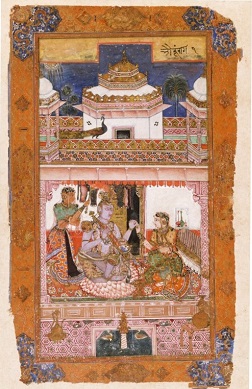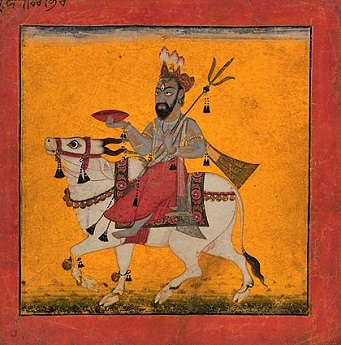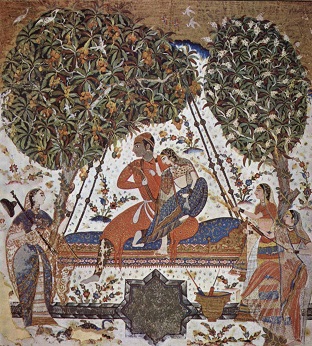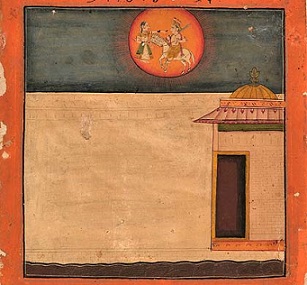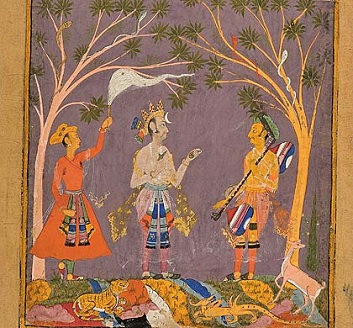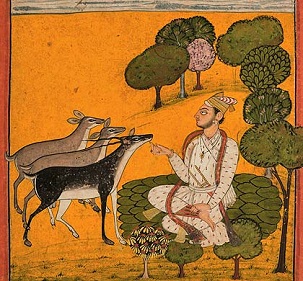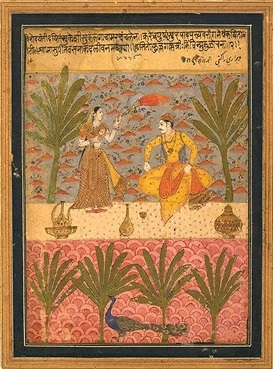Raags/ ragas and Thaats: Hindustani
(→Poorvi) |
(→See also) |
||
| (7 intermediate revisions by one user not shown) | |||
| Line 1: | Line 1: | ||
| + | [[File: Shankara.jpg| Shankara, son of Raag Megh. <br/>Early 17th century, provincial Mughal <br/>Courtesy and (c) Matthew Hollow Photography|frame|500px]] | ||
| + | [[File: Varval.jpg| Varval, son of Raag Malkauns. <br/> Late 17 century, Nûrpur (Hill school: Himachal Pradesh) |frame|500px]] | ||
| + | |||
{| class="wikitable" | {| class="wikitable" | ||
|- | |- | ||
| Line 27: | Line 30: | ||
=The ThaaTs and their raags= | =The ThaaTs and their raags= | ||
==Bilãwal== | ==Bilãwal== | ||
| − | [[File: kakubh.jpg| Kakubh, the little feminine raag. Late 18th century, Hyderabad (Deccan School) |frame|500px]] | + | S-R-G-m-P-D-N-S |
| + | [[File: kakubh.jpg| Kakubh, the little feminine raag.<br/> Late 18th century, Hyderabad (Deccan School) |frame|500px]] | ||
<p class=MsoNormal style='mso-margin-top-alt:auto;mso-margin-bottom-alt:auto; | <p class=MsoNormal style='mso-margin-top-alt:auto;mso-margin-bottom-alt:auto; | ||
line-height:normal'><span style='font-size:12.0pt;font-family:"Times New Roman","serif"; | line-height:normal'><span style='font-size:12.0pt;font-family:"Times New Roman","serif"; | ||
| Line 719: | Line 723: | ||
==Khamãj== | ==Khamãj== | ||
| + | S-R-G-m-P-D-n-S | ||
<p class=MsoNormal style='mso-margin-top-alt:auto;mso-margin-bottom-alt:auto; | <p class=MsoNormal style='mso-margin-top-alt:auto;mso-margin-bottom-alt:auto; | ||
| Line 1,264: | Line 1,269: | ||
==Kãfî== | ==Kãfî== | ||
| − | [[File: Dhanasri.jpg| Dhanashri, the little feminine raag. Late 17th century, Rajasthan |frame|500px]] | + | S-R-g-m-P-D-n-S |
| + | [[File: Dhanasri.jpg| Dhanashri, the little feminine raag.<br/> Late 17th century, Rajasthan |frame|500px]] | ||
<p class=MsoNormal style='mso-margin-top-alt:auto;mso-margin-bottom-alt:auto; | <p class=MsoNormal style='mso-margin-top-alt:auto;mso-margin-bottom-alt:auto; | ||
line-height:normal'><span style='font-size:12.0pt;font-family:"Times New Roman","serif"; | line-height:normal'><span style='font-size:12.0pt;font-family:"Times New Roman","serif"; | ||
| Line 2,417: | Line 2,423: | ||
==Ãsãvarî== | ==Ãsãvarî== | ||
| + | S-R-g-m-P-d-n-S | ||
[[File: Asavari.jpg| Asavari: an early 17th century depiction|frame|500px]] | [[File: Asavari.jpg| Asavari: an early 17th century depiction|frame|500px]] | ||
[[File: Asavari2.jpg| Asavari: mid 18th century, but the depiction of the raag remains the same: a woman sits under a tree, with snakes. |frame|500px]] | [[File: Asavari2.jpg| Asavari: mid 18th century, but the depiction of the raag remains the same: a woman sits under a tree, with snakes. |frame|500px]] | ||
| Line 2,812: | Line 2,819: | ||
==Bhairavî== | ==Bhairavî== | ||
| + | S-r-g-m-P-d-n-S | ||
[[File: Bhairav.jpg| Raag Bhairav: a 16th century painting |frame|500px]] | [[File: Bhairav.jpg| Raag Bhairav: a 16th century painting |frame|500px]] | ||
| Line 3,133: | Line 3,141: | ||
==Bhairav== | ==Bhairav== | ||
| − | + | S-r-G-m-P-d-N-S | |
| + | [[File: Bhairav2.jpg|Raag Bhairav<br/> Late 17 century, Nûrpur (Hill school: Himachal Pradesh) |frame|500px]] | ||
<p class=MsoNormal style='mso-margin-top-alt:auto;mso-margin-bottom-alt:auto; | <p class=MsoNormal style='mso-margin-top-alt:auto;mso-margin-bottom-alt:auto; | ||
line-height:normal'><span style='font-size:12.0pt;font-family:"Times New Roman","serif"; | line-height:normal'><span style='font-size:12.0pt;font-family:"Times New Roman","serif"; | ||
| Line 3,714: | Line 3,723: | ||
==Kalyãn== | ==Kalyãn== | ||
| − | [[File: Hindola.jpg| Raag Hindol | + | S-R-G-M-P-D-N-S |
| − | [[File: Bhaskar.jpg| Bhãskar, the son of Raag Hindol. Early 18th century, Chamba (Hill school: Himachal Pradesh) |frame|500px]] | + | [[File: Hindola.jpg| Raag Hindol<br/> Late 16th century |frame|500px]] |
| − | [[File: Vinod.jpg|Vinod, the son of Raag Hindol. Early 17th century, Deccan |frame|500px]] | + | [[File: Bhaskar.jpg| Bhãskar, the son of Raag Hindol. <br/>Early 18th century, Chamba (Hill school: Himachal Pradesh) <br/>Courtesy and (c) Matthew Hollow Photography|frame|500px]] |
| + | [[File: Vinod.jpg|Vinod, the son of Raag Hindol. <br/> Early 17th century, Deccan <br/>Courtesy and (c) Matthew Hollow Photography |frame|500px]] | ||
<p class=MsoNormal style='mso-margin-top-alt:auto;mso-margin-bottom-alt:auto; | <p class=MsoNormal style='mso-margin-top-alt:auto;mso-margin-bottom-alt:auto; | ||
| Line 4,441: | Line 4,451: | ||
==Mãrwã== | ==Mãrwã== | ||
| − | [[File: Pancham.jpg| Pancham, son of Raag Bhairav. Late 17th century, Basohli (Hill school: Jammu and Kashmir) |frame|500px]] | + | S-r-G-M-P-D-N-S |
| + | [[File: Pancham.jpg| Pancham, son of Raag Bhairav. <br/>Late 17th century, Basohli (Hill school: Jammu and Kashmir) <br/>Courtesy and (c) Matthew Hollow Photography |frame|500px]] | ||
<p class=MsoNormal style='mso-margin-top-alt:auto;mso-margin-bottom-alt:auto; | <p class=MsoNormal style='mso-margin-top-alt:auto;mso-margin-bottom-alt:auto; | ||
line-height:normal'><span style='font-size:12.0pt;font-family:"Times New Roman","serif"; | line-height:normal'><span style='font-size:12.0pt;font-family:"Times New Roman","serif"; | ||
| Line 4,890: | Line 4,901: | ||
==Poorvi== | ==Poorvi== | ||
| − | [[File: varari.jpg| Varari, the little feminine raag. 17th century |frame|500px]] | + | S-r-G-M-P-d-N-S |
| + | [[File: varari.jpg| Varari, the little feminine raag. <br/>17th century |frame|500px]] | ||
<p class=MsoNormal style='mso-margin-top-alt:auto;mso-margin-bottom-alt:auto; | <p class=MsoNormal style='mso-margin-top-alt:auto;mso-margin-bottom-alt:auto; | ||
line-height:normal'><span style='font-size:12.0pt;font-family:"Times New Roman","serif"; | line-height:normal'><span style='font-size:12.0pt;font-family:"Times New Roman","serif"; | ||
| Line 5,290: | Line 5,302: | ||
==ToDî== | ==ToDî== | ||
| + | S-r-g-M-P-d-N-S | ||
[[File: Todi.jpg|The raag Todi is depicted in this Rajasthani miniature painting (13 cm X 18 cm.), as it almost invariably is in Indian art: A young woman with a veena (musical instrument), a deer near her, and a forest or at least a tree close at hand. Such sets of ‘frozen music’ (raags depicted in paintings) are called the rãg-mãlã (Ragamala: the necklace of raags) series|frame|500px]] | [[File: Todi.jpg|The raag Todi is depicted in this Rajasthani miniature painting (13 cm X 18 cm.), as it almost invariably is in Indian art: A young woman with a veena (musical instrument), a deer near her, and a forest or at least a tree close at hand. Such sets of ‘frozen music’ (raags depicted in paintings) are called the rãg-mãlã (Ragamala: the necklace of raags) series|frame|500px]] | ||
| Line 6,553: | Line 6,566: | ||
Hence Indpaedia volunteers, who are not experts either, have constructed this page to the best of their ability. Please guide them through messages sent to the Facebook community, [http://www.facebook.com/Indpaedia Indpaedia.com]. | Hence Indpaedia volunteers, who are not experts either, have constructed this page to the best of their ability. Please guide them through messages sent to the Facebook community, [http://www.facebook.com/Indpaedia Indpaedia.com]. | ||
| + | |||
| + | =See also= | ||
| + | [[Raags/ ragas and Thaats: Hindustani]] | ||
| + | |||
| + | [[Taal/ tãl: Hindustani]] | ||
| + | ==...and also, for Hindi film songs== | ||
| + | ==For lists of popular songs== | ||
| + | If the song that you are looking for has a classical base and you want to know which raag it has been set in, try our year-wise lists. | ||
| + | |||
| + | |||
| + | |||
| + | [[Hindi-Urdu songs: 1931]] | ||
| + | [[Hindi-Urdu songs: 1932]] | ||
| + | [[Hindi-Urdu songs: 1933]] | ||
| + | [[Hindi-Urdu songs: 1934]] | ||
| + | |||
| + | [[Hindi-Urdu songs: 1935]] | ||
| + | [[Hindi-Urdu songs: 1936]] | ||
| + | [[Hindi-Urdu songs: 1937]] | ||
| + | [[Hindi-Urdu songs: 1938]] | ||
| + | [[Hindi-Urdu songs: 1939]] | ||
| + | |||
| + | [[Hindi-Urdu songs: 1940]] | ||
| + | [[Hindi-Urdu songs: 1941]] | ||
| + | [[Hindi-Urdu songs: 1942]] | ||
| + | [[Hindi-Urdu songs: 1943]] | ||
| + | [[Hindi-Urdu songs: 1944]] | ||
| + | |||
| + | [[Hindi-Urdu songs: 1945]] | ||
| + | [[Hindi-Urdu songs: 1946]] | ||
| + | [[Hindi-Urdu songs: 1947]] | ||
| + | [[Hindi-Urdu songs: 1948]] | ||
| + | [[Hindi-Urdu songs: 1949]] | ||
| + | |||
| + | [[Hindi-Urdu songs: 1950]] | ||
| + | [[Hindi-Urdu songs: 1951]] | ||
| + | [[Hindi-Urdu songs: 1952]] | ||
| + | [[Binaca Geet Mala: History and trivia]] | ||
| + | [[Binaca Geet Mala 1953: greatest hits]] | ||
| + | [[Binaca Geet Mala 1954: greatest hits]] | ||
| + | |||
| + | [[Binaca Geet Mala 1955: greatest hits]] | ||
| + | [[Binaca Geet Mala 1956: greatest hits]] | ||
| + | [[Binaca Geet Mala 1957: greatest hits]] | ||
| + | [[Binaca Geet Mala 1958: greatest hits]] | ||
| + | [[Binaca Geet Mala 1959: greatest hits]] | ||
| + | |||
| + | [[Binaca Geet Mala 1960: greatest hits]] | ||
| + | [[Binaca Geet Mala 1961: greatest hits]] | ||
| + | [[Binaca Geet Mala 1962: greatest hits]] | ||
| + | [[Binaca Geet Mala 1963: greatest hits]] | ||
| + | [[Binaca Geet Mala 1964: greatest hits]] | ||
| + | |||
| + | [[Binaca Geet Mala 1965: greatest hits]] | ||
| + | [[Binaca Geet Mala 1966: greatest hits]] | ||
| + | [[Binaca Geet Mala 1967: greatest hits]] | ||
| + | [[Binaca Geet Mala 1968: greatest hits]] | ||
| + | [[Binaca Geet Mala 1969: greatest hits]] | ||
| + | |||
| + | [[Binaca Geet Mala 1970: greatest hits]] | ||
| + | [[Binaca Geet Mala 1971: greatest hits]] | ||
| + | [[Binaca Geet Mala 1972: greatest hits]] | ||
| + | [[Binaca Geet Mala 1973: greatest hits]] | ||
| + | [[Binaca Geet Mala 1974: greatest hits]] | ||
| + | |||
| + | [[Binaca Geet Mala 1975: annual list]] | ||
| + | [[Binaca Geet Mala 1976: annual list]] | ||
| + | [[Binaca Geet Mala 1977: annual list]] | ||
| + | [[Binaca Geet Mala 1978: annual list]] | ||
| + | [[Binaca Geet Mala 1979: annual list]] | ||
| + | |||
| + | [[Binaca Geet Mala 1980: annual list]] | ||
| + | [[Binaca Geet Mala 1981: annual list]] | ||
| + | [[Binaca Geet Mala 1982: annual list]] | ||
| + | [[Binaca Geet Mala 1983: annual list]] | ||
| + | [[Binaca Geet Mala 1984: annual list]] | ||
| + | |||
| + | [[Binaca Geet Mala 1985: annual list]] | ||
| + | [[Cibaca Geet Mala 1986: annual list]] | ||
| + | [[Cibaca Geet Mala 1987: annual list]] | ||
| + | [[Cibaca Geet Mala 1988: annual list]] | ||
| + | [[Cibaca Sangeet Mala 1989: annual list]] | ||
| + | |||
| + | [[Cibaca Sangeet Mala 1990: annual list]] | ||
| + | [[Cibaca Geet Mala 1991: annual list]] | ||
| + | [[Cibaca Geet Mala 1992: annual list]] | ||
| + | [[Cibaca Geet Mala 1993: annual list]] | ||
| + | [[Hindi-Urdu songs: 1994]] | ||
| + | |||
| + | [[Hindi-Urdu songs: 1995]] | ||
| + | [[Hindi-Urdu songs: 1996]] | ||
| + | [[Hindi-Urdu songs: 1997]] | ||
| + | [[Hindi-Urdu songs: 1998]] | ||
| + | [[Hindi-Urdu songs: 1999]] | ||
| + | |||
| + | [[Hindi-Urdu songs: 2000]] [[Hindi-Urdu songs: 2001]] [[Hindi-Urdu songs: 2002]] [[Hindi-Urdu songs: 2003]] [[Hindi-Urdu songs: 2004]] | ||
| + | |||
| + | [[Hindi-Urdu songs: 2005]] [[Hindi-Urdu songs: 2006]] [[Hindi-Urdu songs: 2007]] [[Hindi-Urdu songs: 2008]] [[Hindi-Urdu songs: 2009]] | ||
| + | |||
| + | [[Hindi-Urdu songs: 2010]] [[Hindi-Urdu songs: 2011]] [[Hindi-Urdu songs: 2012]] [[Hindi-Urdu songs: 2013]] [[Hindi-Urdu songs: 2014]] | ||
| + | |||
| + | [[Hindi-Urdu songs: 2015]] [[Hindi-Urdu songs: 2016]] | ||
Revision as of 21:26, 19 September 2017
While the list of ThaaTs is comprehensive, the list of raags is not. |
Contents |
A pronunciation guide
Indians, indeed, South Asians, need not read this guide. They will immediately guess our system, even if they do not know Hindi-Urdu,
For others:
Diacritical marks above vowels double their sound.
A diacritical mark above an ‘ñ’ makes it a nasalised, ‘half’ n as in soNg, briNg, bruNt, caN’t, loNg, ENglish etc.
Capital T and D mean that the T and D are hard, as in the English language.
The capital N denotes a hard n, which non-Indians might find cumbersome. They can stick to the normal n.
Small t and d indicate the soft t and d of Spanish, French and Italian. The d sound is close to the English th (as in THere, THis, THat etc.)
An accentuated é should be pronounced as in French.
The ThaaTs and their raags
Bilãwal
S-R-G-m-P-D-N-S
Notes (swar) used: shuddha (i.e. all swar of the natural scale)
Shown in paintings as: sensuous
Some raags in the ठाट (ThãT) called बिलावल (Bilãwal)
|
अल्हैया बिलावल |
alhaiyã bilãwal |
Morning |
|
बिलावल शुद्ध |
bilãwal shuddh |
Morning |
|
देशकार |
désh kãr |
Morning |
|
देवगिरी बिलावल |
dév-girî bilãwal |
|
|
दुर्गा |
durgã |
Night |
|
हंसध्वनी |
hañsdhwani |
Evening |
|
हेमकल्याण |
hém kalyãN |
|
|
ककुभ |
kakubh |
|
|
लच्छासाख |
lachchhã sãkh |
|
|
मलुहा |
malûhã |
|
|
मांड |
mãñD |
All day |
|
नट बिलावल |
naT bilãwal |
|
|
नट राग |
naT rãg |
|
|
पहाड़ी |
pahãrhî |
Evening |
|
सरपर्दा |
sar pardã |
|
|
शंकरा |
shañkarã |
Evening |
|
शुक्लबिलावल |
shukl bilãwal |
|
|
विहाग |
vihãg |
|
|
यमनी |
yamanî |
|
Khamãj
S-R-G-m-P-D-n-S
Notes (swar) used: The notes of Bilawal, with Komal Nishad instead of Shuddha Nishad.
Mood/ flavour (ras): shriñgãr ras (amorous/ love)
Kinds of music used in: light classical (horî, kajrî, Tappâ, Thumrî)
Shown in paintings as: sensuous, romantic, playful
Some raags in the ठाट (ThãT) called खमाज (khamãj)
The a in dvitîya is almost silent
|
|
bhinn shãdjã |
Night |
|
देस, देश |
dés (sometimes dés[h]) |
Evening |
|
दुर्गा द्वितीय |
durgã dvitîya |
|
|
गारा |
gãrã |
|
|
गोरख कल्याण |
gorakh kalyãN |
Night |
|
जयजयवन्ती |
jaijaivañtî |
Night |
|
झिंझोटी |
jhiñjhoTi |
Night |
|
कलावती |
kalãvati |
Night |
|
खमाज |
khamãj |
Evening |
|
खम्बावती, खंबावती |
khambãvatî |
|
|
रागेश्री, रागेश्वरी |
rãgéshrî (sometimes rãgéshwarî) |
Night |
|
सोरठ |
soraTh |
|
|
तिलक कामोद |
tilak kãmod |
Night |
|
तिलंग |
tilãng |
Evening |
Kãfî
S-R-g-m-P-D-n-S
Notes (swar) used: The notes of Khamaj Thaat + Komal Gãñdhãr
The ‘f’ sound does not exist in Hindi or most Indian languages. They have the ‘ph’ sound instead. Thus, the Hindi word for ‘successful’ is ‘saphal’ and not ‘safal,’ as is almost invariably assumed. For the same reason, you will find some scholarly sites that use the transliteration kãphî (for काफी) instead. It is a mediæval rãg. By then the ‘f’ sound had reached India with the Persian language. Therefore, unless an authority tells us why not, Indpaedia will continue to use the popular pronunciation, which is kãfî. (We repeat: just because safal is the popular pronunciation it does not become correct.)
Some raags in the ठाट (ThãT) called काफ़ी (kãfî):
|
बागेश्री, बागेश्वरी |
bãgéshrî (sometimes bãgéshwarî) |
Night |
|
बहार |
bahãr |
Night |
|
बड़हंससारंग |
barh-hañs sãrañg |
|
|
भीमपलासी |
bhîm-palâsi |
Afternoon |
|
देव साख |
dév-sãkh |
|
|
धनाश्री |
dhanãshrî |
|
|
धानी |
dhãnî |
All day |
|
गौड मल्हार, गौड़मल्लार |
gaurh malhãr (colloquial: mallãr) |
The monsoons |
|
हंसकिंकिणी, हंसकंकणी |
hañs-kiñkiNî (colloquial: hañs-kañkaNî) |
|
|
काफी, काफ़ी |
kãphî, kãfî |
All day (Best: Late evening) |
|
मध्यमादि सारंग |
madhyamãdi-sãrañg |
Afternoon |
|
मालगुंजी |
mãlguñjî |
Night |
|
मल्हार, मल्लार |
malhãr (colloquial: mallãr) |
Night |
|
मेघ |
mégh |
|
|
मियाँ की मल्हार/ मल्लार |
miyãñ kî malhãr |
The monsoons |
|
मियाँ की सारंग |
miyãñ kî sãrañg |
|
|
नायकी कान्हड़ा, नायकी कन्ह्डा |
nãyakî-kãnharhã (or nãyakî-kanharhã) |
|
|
पटदीप |
paT-dîp |
Afternoon |
|
पटमंजरी |
paT-mañjarî |
|
|
पीलू |
pilû |
All day |
|
सैंधवी |
saiñdhvî |
|
|
सामंतसारंग |
sãmañt sãrañg |
|
|
शहाना |
shahãnã |
|
|
शिवरंजनी |
shivrañjini
|
Night |
|
शुद्ध मल्हार/ मल्लार |
shuddh malhãr |
|
|
शुद्ध सारंग |
shuddh sãrañg |
|
|
सिन्धुरा, सिंदूरा |
siñdhûrã, siñdûrã |
|
|
सुघराई |
sughrãî |
|
|
सूहा |
sûhã |
|
|
सूर मल्हार, सूरमल्लार |
sur malhãr |
|
|
वृन्दावनी सारंग |
vriñdãvanî sãrañg |
|
Ãsãvarî
S-R-g-m-P-d-n-S
Notes (swar) used: The notes of Kafi + Komal Dhaivat
Mood: austere, ascetic, renunciatory.
Some raags in the ठाट (ThãT) called आसावरी (ãsãvarî)
|
अडाणा |
aDãNã |
Evening/ night |
|
आसावरो |
ãsãvarî |
Late morning |
|
दरबारी कान्हड़ा |
darbãrî kãnharhã |
Evening/ night |
|
देसी |
désî |
Morning |
|
देव गन्धार |
dév gañdhãr |
|
|
जौनपुरी |
jaun-purî |
Morning |
|
कौशिक कान्हड़ा |
kaushik kãnharhã |
|
|
नायकी द्वितीय |
nãyakî dvitîya |
|
|
षट्राग |
shaT-rãg |
|
|
सिंधुभैरवी |
siñdhu bhairavi |
|
Bhairavî
S-r-g-m-P-d-n-S
Notes (swar) used: All the komal swars, dhaivat (A), gandhar (E), nishad (B), rishabh (D). All 12 notes are used in compositions in Bhairavi.
‘Gender’: Feminine
Mood: Solemn.
Shown in paintings as: Feminine, as the divine wife of Bhairav (Lord Shiv).
Some raags in the ठाट (ThãT) called भैरवी (bhairavî)
|
भैरवी |
bhairavî |
All day |
|
भूपाल तोडी |
bhûpãl toDî, bhûpãlî toDî |
Morning |
|
बिलासखानी तोड़ी |
bilãskhãnî torhî (toDî) |
Morning |
|
धनाश्री |
dhanãshrî |
|
|
कौसी कान्ह्डा |
kauñsî kãnharhã; kausî… |
|
|
मालकौंस |
mãlkauñs |
Night |
|
मालकौंस पंचम |
mãlkauñs pañcham |
Night |
Bhairav
S-r-G-m-P-d-N-S
Notes (swar) used: Komal Rishabh and Komal Dhaivat
Gender: masculine
Shown in paintings as: Ascetic, overwhelming
Some raags in the ठाट (ThãT) called भैरव (bhairav)
|
अहीर भैरव |
ahîr bhairav |
Morning |
|
आनंद भैरव |
ãnañd bhairav |
|
|
बैरागी भैरव |
bairãgi bhairav |
Morning |
|
बंगाल भैरव |
bañgãl bhairav |
|
|
भैरव |
bhairav |
Morning (see variations) |
|
गुणकली |
guN-kalî |
Morning |
|
जोगिया |
jogiyã |
Morning |
|
कालिंगड़ा |
kãliñgrhã |
Morning
|
|
मेघरंजनी |
mégh-rañjani |
|
|
नट भैरव |
naT bhairav |
Morning |
|
प्रभात |
prabhãt |
|
|
रामकली |
rãm-kali |
|
|
सौराष्ट्रटंक |
saurãshTr-Tañk |
|
|
शिवभैरव |
shiv bhairav |
|
|
विभाग |
vibhãg |
|
Some variants of Raag Bhairav: ahîr bhairav, alam bhairav, ãñañd bhairav, bairãgî bhairav, beehad bhairav, bhavmat bhairav, dévatã bhairav, gaurî bhairav, naT bhairav, shivmat bhairav.
Kalyãn
S-R-G-M-P-D-N-S
Distinguishing swar: teevr madhyam. (Indeed, it is teevr madhyam that differentiates evening/ night raags from dawn and sunset raags.
Mood: Feel-good
Some raags in the ठाट (ThãT) called कल्याण (kalyãN)
|
भूपाली |
bhûpãlî |
Evening |
|
बिहाग |
bihãg |
Night |
|
केदार |
chãñdnî kédãr |
Night |
|
चन्द्रकान्त |
chañdr-kãñt |
|
|
छाया-नट |
chhãyã-naT |
Night |
|
गौड़ सारंग |
gaurh sãrañg |
Afternoon |
|
हमीर |
hamîr |
Night |
|
हिन्डोल |
hiñDol |
Morning |
|
जयतकल्याण |
jayat kalyãN |
|
|
कामोद |
kãmod |
Evening |
|
केदार |
kédãr |
Night |
|
मालश्री |
mãl-shree |
|
|
मारू बिहाग |
mãru bihãg |
Evening |
|
नंद |
nañd
|
Night |
|
श्याम कल्याण |
shãm kalyãN |
Evening |
|
शुद्ध कल्याण |
shuddh kalyãN |
Evening |
|
शुद्ध सारंग |
shuddh sãrañg |
Afternoon |
|
श्याम |
shyãm |
|
|
यमन |
yaman |
Evening |
|
यमन कल्याण |
yaman kalyãN |
Evening |
Variations include: ãñañdî kalyãN, khém kalyãN, savani kalyãN.
Mãrwã
S-r-G-M-P-D-N-S
Notes (swar) used: kalyãN Thaat plus komal rishabh.
Mood: Dusk. The end of the day, the coming of the night.
Some raags in the ठाट (ThãT) called मारवा (mãrwã)
|
भंखार |
bhañkhãr |
Morning |
|
भटियार |
bhaTiyãr |
Morning |
|
जैत |
jait |
|
|
ललित |
laliT |
Morning |
|
मालीगौरा |
mãlîgaurã |
|
|
मारवा |
mãrwã |
Afternoon |
|
पंचम |
pañcham |
|
|
पूरिया |
pûriyã |
Evening |
|
साजगिरी |
sãjgirî |
|
|
सोहनी |
sohinî |
Morning |
|
वराटी |
varãTî |
|
|
विभास |
vibhãs; bibhãs |
Morning |
Poorvi
S-r-G-M-P-d-N-S
Notes (swar) used: mãrwã Thaat plus komal dhaivat.
Mood: Serious
Shown in paintings as: graceful.
Some raags in the ठाट (ThãT) called पूर्वी (pûrvî):
|
बसन्त |
basañt |
Night |
|
गौरी (भैरव अंग) |
gaurî |
|
|
जेतश्री |
jét-shrî |
|
|
मालश्री |
mãl-shrî |
|
|
परज |
paraj |
|
|
पुरिया धनाश्री, पूर्याधनाश्री |
pûriyã-dhanãshrî |
Evening |
|
पूर्वी |
pûrvî |
Afternoon |
|
श्रीराग |
shrî-rãg |
Afternoon |
|
टंकी |
Tañkî |
|
|
त्रिवेणी |
trivéNî |
|
ToDî
S-r-g-M-P-d-N-S
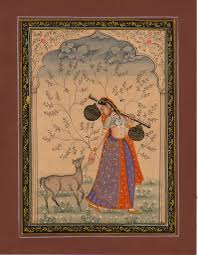
Mood: Serene, sylvan, musical.
Some raags in the ठाट (ThãT) called तोड़ी (torhî is invariably spelt toDî, therefore, Indpaedia has succumbed)
|
गुजरी तोडी |
gujari todi; gurjari toDî |
Morning |
|
मधुवन्ती |
madhuvañti |
Afternoon |
|
मियाँ की तोडी |
miyãñ ki todi, |
|
|
मुलतानी |
multãnî |
Afternoon |
|
तोड़ी |
toDî (14 varieties) |
Morning |
Other Raags
|
अभोगी कान्ह्डा |
abhogî kãnharhã |
|
|
बैरागी तोडी |
bairãgi toDî |
|
|
बसन्त मुखारी |
basañt mukhãrî |
Morning |
|
भीम |
bhîm |
|
|
चन्द्रकौन्स |
chañdr-kauñs |
Night |
|
चारुकेशी |
chãrûkéshi |
|
|
गोपिका बसन्त |
basañt |
|
|
हरिकौन्स |
hari-kauñs |
|
|
हेमश्री |
hém-shrî |
|
|
जलधर केदार |
jal-dhar kédãr |
|
|
|
jan-sammohini |
|
|
जोगेश्वरी |
jogéshwarî |
|
|
कौशिक ध्वनी |
kaushik dhwanî |
|
|
कीरवाणी |
kîrwãNî |
Night |
|
कोमल-रिषभ आसावरी |
komal rishabh ãsãvarî |
|
|
लंका-दहन सारंग |
lañkã-dahan sãrañg |
|
|
मधुमाद सारंग |
madhu-mãd sãrañg |
|
|
मोहन कौन्स |
mohan-kauñs |
|
|
नारायणी |
nãrãyaNî |
|
|
परमेश्वरी |
parméshwarî |
|
|
पटदीपकी |
paT-dîpakî |
|
|
पुरिया कल्याण |
puriyã kalyãN |
|
|
सरस्वती |
saraswatî |
|
|
सरस्वती केदार |
saraswatî kédãr |
|
|
शहाना कन्ह्डा |
shahãnã kanharhã |
|
|
शोभावरी |
shobhã-varî |
|
|
सुहासुघराई |
sûhã sughrãî |
|
|
सुन्दर कौन्स |
suñdar kauñs |
|
|
तिलंग बहार |
tilãng bahãr |
|
|
वाचस्पती |
vãchaspati |
|
Why this page?
This page was created in order to give laymen just the names and correct pronunciations of the Ten Thaats and the important raags/ ragas. (However, as the page grows it will have other information as well. It already does.)
Why should Indians, especially those who can read Hindi in Devanagari, need pronunciation guides to their own raags/ ragas?
Because of all the inaccurate information available in print and on the internet. Because of spellings like सिंदूरा (instead of सिन्धुरा), हिंदोल (instead of हिन्डोल), हामीर (instead of हमीर), जेजैवंती (instead of जयजयवन्ती or जैजैवंती; our problem is with the first जे, which should have been a जै), वसंत (instead of बसन्त), हंसकंकणी (instead of हंसकिंकिणी), मल्लार (instead of मल्हार), ललिट and Lalat (instead of ललित and Lalit), जैनपुरी (instead of जौनपुरी), र्गाधार (instead of गन्धार), देश (instead of देस), haunsdhwani (instead of hañsdhwani), रागेश्वरी (instead of रागेश्री) and बागेश्वरी (instead of बागेश्री). All these mistakes have been made by scholarly publications.
This tends to confuse even those who know the basics of Hindustani classical music.
Hence Indpaedia volunteers, who are not experts either, have constructed this page to the best of their ability. Please guide them through messages sent to the Facebook community, Indpaedia.com.
See also
Raags/ ragas and Thaats: Hindustani
...and also, for Hindi film songs
For lists of popular songs
If the song that you are looking for has a classical base and you want to know which raag it has been set in, try our year-wise lists.
Hindi-Urdu songs: 1931 Hindi-Urdu songs: 1932 Hindi-Urdu songs: 1933 Hindi-Urdu songs: 1934
Hindi-Urdu songs: 1935 Hindi-Urdu songs: 1936 Hindi-Urdu songs: 1937 Hindi-Urdu songs: 1938 Hindi-Urdu songs: 1939
Hindi-Urdu songs: 1940 Hindi-Urdu songs: 1941 Hindi-Urdu songs: 1942 Hindi-Urdu songs: 1943 Hindi-Urdu songs: 1944
Hindi-Urdu songs: 1945 Hindi-Urdu songs: 1946 Hindi-Urdu songs: 1947 Hindi-Urdu songs: 1948 Hindi-Urdu songs: 1949
Hindi-Urdu songs: 1950 Hindi-Urdu songs: 1951 Hindi-Urdu songs: 1952 Binaca Geet Mala: History and trivia Binaca Geet Mala 1953: greatest hits Binaca Geet Mala 1954: greatest hits
Binaca Geet Mala 1955: greatest hits Binaca Geet Mala 1956: greatest hits Binaca Geet Mala 1957: greatest hits Binaca Geet Mala 1958: greatest hits Binaca Geet Mala 1959: greatest hits
Binaca Geet Mala 1960: greatest hits Binaca Geet Mala 1961: greatest hits Binaca Geet Mala 1962: greatest hits Binaca Geet Mala 1963: greatest hits Binaca Geet Mala 1964: greatest hits
Binaca Geet Mala 1965: greatest hits Binaca Geet Mala 1966: greatest hits Binaca Geet Mala 1967: greatest hits Binaca Geet Mala 1968: greatest hits Binaca Geet Mala 1969: greatest hits
Binaca Geet Mala 1970: greatest hits Binaca Geet Mala 1971: greatest hits Binaca Geet Mala 1972: greatest hits Binaca Geet Mala 1973: greatest hits Binaca Geet Mala 1974: greatest hits
Binaca Geet Mala 1975: annual list Binaca Geet Mala 1976: annual list Binaca Geet Mala 1977: annual list Binaca Geet Mala 1978: annual list Binaca Geet Mala 1979: annual list
Binaca Geet Mala 1980: annual list Binaca Geet Mala 1981: annual list Binaca Geet Mala 1982: annual list Binaca Geet Mala 1983: annual list Binaca Geet Mala 1984: annual list
Binaca Geet Mala 1985: annual list Cibaca Geet Mala 1986: annual list Cibaca Geet Mala 1987: annual list Cibaca Geet Mala 1988: annual list Cibaca Sangeet Mala 1989: annual list
Cibaca Sangeet Mala 1990: annual list Cibaca Geet Mala 1991: annual list Cibaca Geet Mala 1992: annual list Cibaca Geet Mala 1993: annual list Hindi-Urdu songs: 1994
Hindi-Urdu songs: 1995 Hindi-Urdu songs: 1996 Hindi-Urdu songs: 1997 Hindi-Urdu songs: 1998 Hindi-Urdu songs: 1999
Hindi-Urdu songs: 2000 Hindi-Urdu songs: 2001 Hindi-Urdu songs: 2002 Hindi-Urdu songs: 2003 Hindi-Urdu songs: 2004
Hindi-Urdu songs: 2005 Hindi-Urdu songs: 2006 Hindi-Urdu songs: 2007 Hindi-Urdu songs: 2008 Hindi-Urdu songs: 2009
Hindi-Urdu songs: 2010 Hindi-Urdu songs: 2011 Hindi-Urdu songs: 2012 Hindi-Urdu songs: 2013 Hindi-Urdu songs: 2014
